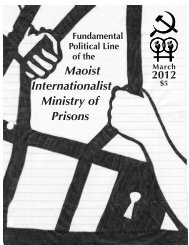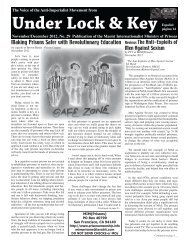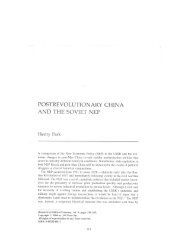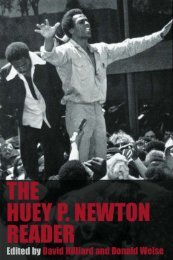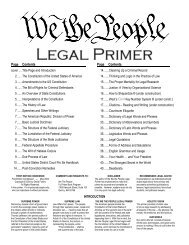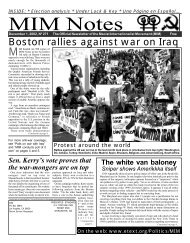Mythology of the White Proletariat - San Francisco Bay Area ...
Mythology of the White Proletariat - San Francisco Bay Area ...
Mythology of the White Proletariat - San Francisco Bay Area ...
Create successful ePaper yourself
Turn your PDF publications into a flip-book with our unique Google optimized e-Paper software.
while <strong>the</strong> evil planter and <strong>the</strong> London merchant grew fat<br />
on <strong>the</strong> pr<strong>of</strong>its <strong>of</strong> <strong>the</strong> slave labor, <strong>the</strong> "poor white" <strong>of</strong> <strong>the</strong><br />
South, <strong>the</strong> Nor<strong>the</strong>rn small farmer and white worker were<br />
all uninvolved in slavery and benefited not at all from it.<br />
The mythology suggests that slavery even lowered <strong>the</strong> living<br />
standard <strong>of</strong> <strong>the</strong> white masses by supposedly holding<br />
down wages and monopolizing vast tracts <strong>of</strong> farmland.<br />
Thus, it is alleged, slavery was not in <strong>the</strong> interests <strong>of</strong> <strong>the</strong><br />
white masses.*<br />
Yet Karl Marx observed: "Cause slavery to disappear<br />
and you will have wiped America <strong>of</strong>f <strong>the</strong> map <strong>of</strong> nations."(l5)<br />
Marx was writing during <strong>the</strong> zenith <strong>of</strong> <strong>the</strong> cotton<br />
economy <strong>of</strong> <strong>the</strong> mid-1800s, but this most basic fact is<br />
true from <strong>the</strong> bare beginnings <strong>of</strong> European settlement in<br />
Amerika. Without slave labor <strong>the</strong>re would have been no<br />
Amerika. It is as simple as that. Long before <strong>the</strong> cotton<br />
economy <strong>of</strong> <strong>the</strong> South flourished, for example, Afrikan<br />
slaves literally built <strong>the</strong> City <strong>of</strong> New York. Their work<br />
alone enabled <strong>the</strong> original Dutch settlers to be fed and<br />
sheltered while pursuing <strong>the</strong>ir drinking, gambling, furtrading<br />
and o<strong>the</strong>r non-laboring activities. Afrikans were<br />
not only much <strong>of</strong> early New York's farmers, carpenters,<br />
and blacksmiths, but also comprised much <strong>of</strong> <strong>the</strong> City's<br />
guards.<br />
The Dutch settlers were so dependent on Afrikan<br />
labor for <strong>the</strong> basics <strong>of</strong> life that <strong>the</strong>ir Governor finally had<br />
to grant some Afrikan slaves both freedom and land in<br />
return for <strong>the</strong>ir continued food production. The Afrikanowned<br />
land on Manhattan included what is now known as<br />
Greenwich Village, Astor Place, and Herald Square.<br />
Later, <strong>the</strong> English settlers would pass laws against Afrikan<br />
land ownership, and take <strong>the</strong>se tracts from <strong>the</strong> free<br />
Afrikans. Manhattan was thus twice stolen from oppressed<br />
peoples. (1 6)<br />
Indian slavery was also important in supporting<br />
<strong>the</strong> settler invasion beachhead on <strong>the</strong> "New World". From<br />
New England (where <strong>the</strong> pious Pilgrims called <strong>the</strong>m<br />
"servants") to South Carolina, <strong>the</strong> forced labor <strong>of</strong> Indian<br />
slaves was essential to <strong>the</strong> very survival <strong>of</strong> <strong>the</strong> young Colonies.<br />
In fact, <strong>the</strong> pr<strong>of</strong>its from <strong>the</strong> Indian slave trade were<br />
<strong>the</strong> economic mainstay <strong>of</strong> <strong>the</strong> settler invasion <strong>of</strong> <strong>the</strong><br />
Carolinas. In 1708 <strong>the</strong> English settlements in <strong>the</strong> Carolinas<br />
had a population <strong>of</strong> 1,400 Indian slaves and 2,900 Afrikan<br />
slaves to 5,300 Europeans. Indian slaves were common<br />
throughout <strong>the</strong> Colonies-in 1730 <strong>the</strong> settlers <strong>of</strong> Kingston,<br />
Rhode Island had 223 Indian slaves (as well as 333 Afrikan<br />
slaves). As late in 1740 we know that some 14,000 Indian<br />
slaves labored in <strong>the</strong> plantations <strong>of</strong> South Carolina.(l7)<br />
The recorded number <strong>of</strong> Indian slaves within Colonial<br />
English settlements was only a small indication <strong>of</strong> <strong>the</strong><br />
larger picture, since most Indian slaves were sold to<br />
Jamaica, Barbados and o<strong>the</strong>r West Indian colonies. One<br />
reason for <strong>the</strong> depopulation <strong>of</strong> <strong>the</strong> once numerous Indian<br />
peoples <strong>of</strong> <strong>the</strong> Sou<strong>the</strong>rn Colonies was <strong>the</strong> unrestrained<br />
ravages <strong>of</strong> <strong>the</strong> slave trade. In <strong>the</strong> first five decades <strong>of</strong> <strong>the</strong><br />
English settlement <strong>of</strong> <strong>the</strong> Carolinas, it appears that <strong>the</strong><br />
* Similar arguments relative to today are advanced by <strong>the</strong><br />
b'Don't-Divide-The-Working-Class" revisionists, who<br />
want to convince us that <strong>the</strong> Euro-Amerikan masses are<br />
"victims <strong>of</strong> imperialism" just like us.<br />
main cash export item was Indian slaves. Armed expeditions,<br />
made up largely <strong>of</strong> Indian puppet soldiers already<br />
addicted to rum and o<strong>the</strong>r capitalist consumer goods,<br />
scoured <strong>the</strong> countryside for Indians to capture and sell.<br />
The total sold away is unknown, but large. We do know<br />
that in just six years after 1704, some 12,000 Indian slaves<br />
were sold out <strong>of</strong> Charleston to <strong>the</strong> West Indies.(l8)<br />
Additional uncounted thousands <strong>of</strong> Indian slaves<br />
were exported from <strong>the</strong> o<strong>the</strong>r settlements <strong>of</strong> <strong>the</strong> Middle<br />
and New England Colonies. Indian slaves in large numbers<br />
were very difficult to deal with, since <strong>the</strong> settlers were trying<br />
to hold <strong>the</strong>m on terrain that was more <strong>the</strong>irs than <strong>the</strong><br />
invaders. Usually, <strong>the</strong> minimum precaution would be to in<br />
effect swap Indian slaves around, with New England using<br />
slaves from Sou<strong>the</strong>rn Colonies-and vice-versa. In most<br />
cases <strong>the</strong> slave catchers killed almost all <strong>the</strong> adult Indian<br />
men as too dangerous to keep around, only saving <strong>the</strong><br />
women and children for sale.(l9)<br />
But by 1715 <strong>the</strong> "divers conspiracies, insurrections<br />
..." <strong>of</strong> rebellious Indian slaves had reached <strong>the</strong> point<br />
where all <strong>the</strong> New England Colonies barred any fur<strong>the</strong>r imports<br />
<strong>of</strong> Indian slaves.(20) The Pilgrims <strong>of</strong> New England<br />
had seen that <strong>the</strong> most pr<strong>of</strong>itable and safe use <strong>of</strong> <strong>the</strong>ir Indian<br />
slaves was to sell <strong>the</strong>m abroad. Indeed, <strong>the</strong> wife and<br />
nine year-old son <strong>of</strong> "King Philip", <strong>the</strong> great leader <strong>of</strong> <strong>the</strong><br />
1675 Indian uprising, were sold into West Indian captivity<br />
(as was even <strong>the</strong>n customary with many captured Indians).<br />
Thus, <strong>the</strong> early settlers were not just <strong>the</strong> passive<br />
beneficiaries <strong>of</strong> a far-<strong>of</strong>f Afrikan slave trade-<strong>the</strong>y<br />
bankrolled <strong>the</strong>ir settlements in part with <strong>the</strong> pr<strong>of</strong>its <strong>of</strong> <strong>the</strong>ir<br />
own eager explorations into Native slave trading. The<br />
point is that <strong>White</strong> Amerika has never been self-sufficient,<br />
has never completely supported itself. Indian slavery died<br />
out, and was gradually lost in <strong>the</strong> great river <strong>of</strong> Afrikan<br />
slavery, only because <strong>the</strong> settlers finally decided to exterminate<br />
<strong>the</strong> heavily depopulated Indian nations altoge<strong>the</strong>r.<br />
The essence is not <strong>the</strong> individual ownership <strong>of</strong><br />
slaves, but ra<strong>the</strong>r <strong>the</strong> fact that world capitalism in general<br />
and Euro-Amerikan capitalism in specific had forged a<br />
slave-based economy in which all settlers gained and took<br />
part. Historian Samuel Eliot Morison, in his study <strong>of</strong> The<br />
European Discovery <strong>of</strong> America, notes that after repeated<br />
failures <strong>the</strong> Europeans learned that North Amerikan settler<br />
colonies were not self-sufficient; to survive <strong>the</strong>y needed<br />
large capital infusions and <strong>the</strong> benefits <strong>of</strong> sustained trade<br />
with Fa<strong>the</strong>r Europe.(21) But why should <strong>the</strong> British<br />
aristocracy and capitalists invest in small family<br />
farms-and how great a trade is possible when what <strong>the</strong><br />
settlers <strong>the</strong>mselves produced was largely <strong>the</strong> very raw<br />
materials and foodstuffs <strong>the</strong>y <strong>the</strong>mselves needed? Slavery<br />
throughout <strong>the</strong> "New World" answered <strong>the</strong>se questions. It<br />
was <strong>the</strong> unpaid, expropriated labor <strong>of</strong> millions <strong>of</strong> Indian<br />
and Afrikan captive slaves that created <strong>the</strong> surpluses on<br />
which <strong>the</strong> settler economy floated and Atlantic trade<br />
flourished.<br />
So all sections <strong>of</strong> white settler society-even <strong>the</strong> artisan,<br />
worker, and farmer-were totally dependent upon<br />
Afrikan slave labor: <strong>the</strong> fisherman whose<br />
low-grade,"refuse fish" was dried and sold as slave meal<br />
in <strong>the</strong> Indies; <strong>the</strong> New York farmer who found his market<br />
for surpluses in <strong>the</strong> Sou<strong>the</strong>rn plantations; <strong>the</strong> forester




